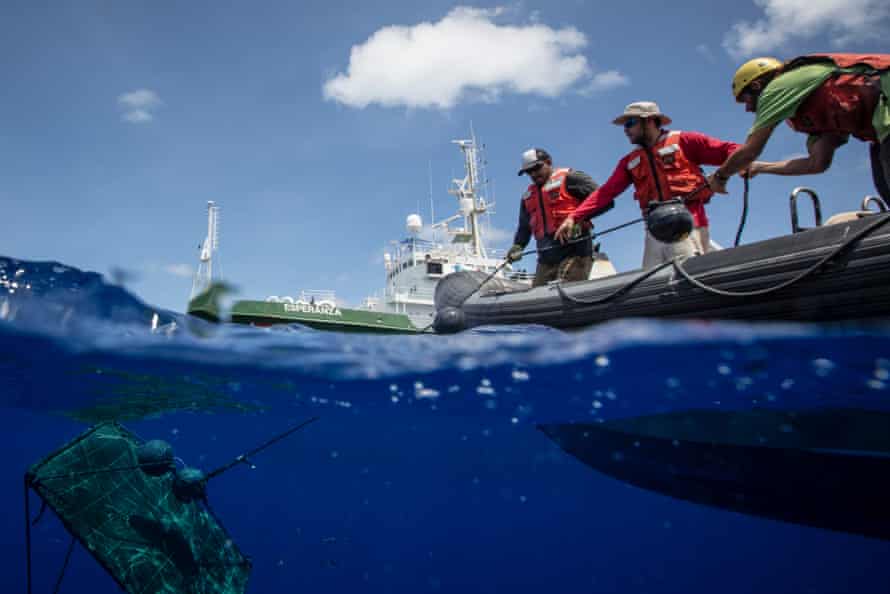Global condemnation is growing at the increasingly widespread use of harmful “fish aggregating devices” (FADs) in the fishing industry, as retailers including Sainsbury’s, Marks & Spencer and the German chain Edeka joined calls for restrictions.
A letter signed by more than 100 NGOs, retailers and artisanal fisheries urges this week’s meeting of the Indian Ocean Tuna Commission (IOTC) to consider proposals by Kenya and Sri Lanka to monitor, manage and restrict FADs. The signatories warn of an “urgent need” to improve management of FADs in order to reduce overfishing and rebuild populations of yellowfin tuna.
FADs are floating buoys or other objects that cast a shadow, which attracts schools of fish. Artisanal fishers, long recognising that fish gather under logs, have used similar aids for centuries, but the increasing use of “drifting” FADs by industrial fishing fleets is causing concern among fishery managers and conservationists.
By casting nets near FADs, vessels can increase their catch, but using the devices leads to more bycatch, including juvenile tuna that have not had a chance to reproduce.
Marks & Spencer warned that FADs posed a “serious threat” to the recovery of overfished yellowfin tuna in the Indian Ocean. It urged regulators and fishing nations to adopt measures to restrict and manage the devices, in order to tackle overfishing, as well as marine plastic pollution and accidental bycatch of turtles, sharks and marine mammals.
By adding their voices to the overfishing debate, particularly in the Indian Ocean, the companies join Tesco, Co-op and Princes, who recently called for tough action to rebuild the ocean’s yellowfin tuna stocks.
Although the EU and the Maldives have made proposals to the IOTC, which regulates tuna stocks and is meeting this week to decide how to reduce overfishing and rebuild populations, neither proposal included control of FADs. Marks & Spencer did not sign the letter but on Monday wrote to IOTC delegates in support of the proposals by Kenya, Sri Lanka and the Maldives.
A spokesperson for J Sainsbury plc said none of its tuna is caught using FADs. The retailer began offering consumers FAD-free tuna in 2018, in addition to pole- and line-caught tuna, in order to expand customers’ choice. Edeka also uses pole- and line-caught tuna.

The EU distant water fleet, which was last week accused by developing coastal states of “neocolonial” plundering of tuna in the Indian Ocean, is made up of industrial purse seiner vessels and is a major user of “drifting FADs”, which are untethered and have netting underneath. Drifting FADs are the main target of the Kenya-Sri Lanka proposal.
Research has linked the use of drifting FADs to increased catch of smaller and younger yellowfin and bigeye tuna. The IOTC’s own working party expressed this concern over the devices three years ago. “[The use of FADs] has increased the amount of bycatch (including some species classified as vulnerable or endangered) and has likely resulted in adverse effects on the ecology of fish and on vulnerable areas (eg beaching events on coral reef areas).”
Among the signatories to the letter to the IOTC are the WWF and the International Pole & Line Foundation (IPNLF). Marcel Kroese of WWF said: “Considering the majority of the catch from industrial fisheries ends up as canned tuna in the EU and the UK, or sashimi in Japan and the United States, WWF and our partners call for a rigorous management approach that recognises tuna’s vital role in food security, income generation and economic development for the marginalised communities of the Indian Ocean coastal states.”
“The ecological damage caused by drifting FADs through ghost fishing, plastic pollution and damage to sensitive coastal habitats such as corals are felt long after they’ve been lost, abandoned or discarded,” said Martin Purves, the managing director of the IPNLF, a UK-based charity that works with tuna fisheries using low-impact fishing gear.
“These devices are not only causing devastation of the yellowfin stock but are leaving coastal communities to deal with the mess they leave behind.”
The proposal by Kenya and Sri Lanka recommends banning the use of drifting FADs for three months from 1 July to 31 September, and reducing the number of FADs for each vessel from 300 to 150.
While the total yellowfin tuna catch in the Indian Ocean is almost equally split between industrial and artisanal vessels, conservationists say it is the industrial catch around FADs that’s driving overfishing. About 97% of the catch around drifting FADs were juvenile yellowfin, according to the Blue Marine Foundation. In contrast, 36% of the Maldives handline and pole- and line-catch were juvenile yellowfin, according to the INPLF.